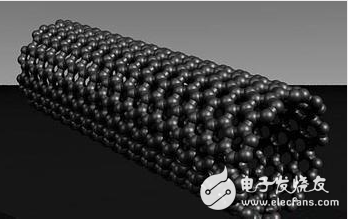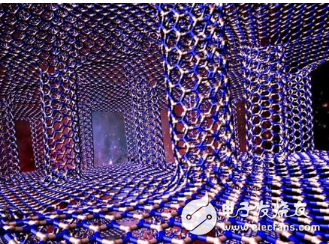Nanomaterials refer to materials that have at least one dimension in the three-dimensional space in the nanoscale range (1 nm to 100 nm) or are composed of them as basic units. This refers to a change in the properties caused by the sharp increase in the ratio of the number of atoms on the surface of the nanocrystal particles to the total number of atoms as the particle size becomes smaller. For example, when the particle diameter is 10 nm, the particles contain 4000 atoms, and the surface atoms account for 40%; when the particle diameter is 1 nm, the particles contain 30 atoms, and the surface atoms account for 99%. Since nanomaterials are composed of tiny units equivalent to molecular size or even atomic size, it is precisely because of this that nanomaterials have some physical or chemical properties that are different from other materials formed by the same chemical elements, such as their mechanical properties. , electrical properties, magnetic properties, thermal properties, etc., these properties have been applied in various scientific and technological fields that are currently developing rapidly. The size of the nanoparticles is small, the surface energy is high, and the surface atoms occupy a considerable proportion. As the particle size decreases, the number of surface atoms increases rapidly. This is due to the small particle size and the sharp increase in surface area. Due to the increased number of surface atoms, insufficient atomic coordination and high surface energy, these surface atoms are highly active, extremely unstable, and easily bind to other atoms. For example, metal nanoparticles will burn in the air, and inorganic nanoparticle voids will adsorb and react with gases when exposed to air. The surface effect of a nanomaterial refers to a change in properties caused by a sharp increase in the ratio of the number of surface atoms of a nanoparticle to the total number of atoms as the particle diameter becomes smaller. As the particle size becomes smaller, the percentage of surface atoms will increase significantly. When the particle size is reduced to 1 nm, the ratio of the number of surface atoms reaches about 90%, and the atoms are almost entirely concentrated on the surface of the nanoparticles. Due to the increase in the number of atoms on the surface of the nanoparticles, the insufficient coordination of the surface atoms and the high surface energy, these atoms are easily combined with other atoms and stabilized, so they have high chemical activity. When the size of the ultrafine particles is equal to or smaller than the physical characteristic size such as the wavelength of the light wave, the wavelength of De Broglie, and the coherence length or transmission depth of the superconducting state, the periodic boundary conditions of the crystal will be destroyed; the amorphous nanoparticles are The atomic density near the surface layer of the particle is reduced, resulting in a new small size effect of acoustic, optical, electromagnetic, and thermodynamic waiting. For example, the plasmon resonance frequency shift of the light absorption significantly increases and the absorption peak; the transition of the magnetic ordered state to the magnetic disordered state; the transition of the superconducting phase to the normal phase; the change of the phonon spectrum, etc. The change in macroscopic physical properties due to the smaller particle size is called the small size effect. For ultrafine particles, the size becomes smaller and the specific surface area increases, resulting in a series of novel properties: (1) Mechanical properties (2) Thermal properties The specific heat and coefficient of thermal expansion of nanomaterials are greater than those of similar coarse-grained materials and amorphous materials. This is due to the disordered arrangement of interfacial atoms, low atomic density, and weak coupling of interface atoms. Therefore, it has broad application prospects in the application of mechanical coupling properties of heat storage materials and nanocomposites. (3) Electrical properties Due to the increase in atomic volume fraction at the crystal interface, the resistance of nanomaterials is higher than that of similar coarse-grained materials, and even the size-induced metal-insulator transition (SIMIT) occurs. The nano-electronic devices made by the tunnel quantum effect and Coulomb plugging effect of nanoparticles have the characteristics of ultra-high speed, ultra-capacity, ultra-miniature and low power consumption, and it is possible to completely replace the conventional semiconductor devices in the near future. (4) Magnetic properties The small-sized ultrafine particle magnetism is significantly different from the bulk material and exhibits superparamagnetism. The use of magnetic ultrafine particles with high coercivity has made magnetic recording magnetic powder with high storage density, which is widely used in magnetic tapes, magnetic disks, magnetic cards and the like. Utilizing superparamagnetism, magnetic ultrafine particles have been made into magnetic fluids with a wide range of uses. When the particle size drops to a certain value, the electron energy level near the metal Fermi level changes from quasi-continuous to discrete energy level and the nano-semiconductor particles have discontinuous highest occupied molecular orbital and lowest orbital energy level. The widening of the energy gap is called the quantum size effect. The quantum size effect directly explains the special thermal energy, magnetic energy, magnetostatic energy, electrostatic energy, photon energy, and superconducting condensed energy of nanoparticles, which are significantly different from macroscopic characteristics. The ability of microscopic particles to have a barrier through it is called tunneling. In recent years, some macroscopic quantities have been discovered, such as the magnetization of microparticles, and the magnetic flux in quantum coherent devices also have tunneling effects, called macroscopic quantum tunneling. The study of macroscopic quantum tunneling has important implications for basic research and practicality. It limits the time limit for tape and disk storage of information. Quantum size effects, tunneling will be the basis for future microelectronic devices, or it will establish the limits of further miniaturization of existing microelectronic devices. When the microelectronic device is further miniaturized, the quantum effect described above must be considered. 1. Peculiar optical properties: One is the strong absorption in the wide band: the reflectance of the nanoparticles to light is very low, and the absorption rate is very strong, causing the particles to turn black. The second is the blue shift phenomenon: the absorption band of the nanoparticles generally moves in the short wave direction. Third, the nanoparticles have a new luminescence phenomenon that does not occur in conventional materials. 2. Diffusion and sintering properties: These interfaces provide a short-range diffusion path for atoms due to the large interface in the nanostructured materials. Therefore, the nanostructure has a higher diffusivity than the single crystal material. The higher diffusion rate has a significant effect on the mechanical properties such as creep and superplasticity. At the same time, the material can be effectively doped at a lower temperature, and the immiscible metal can form a new alloy phase at a lower temperature. Another result of the enhanced diffusion capacity is that the sintering temperature of the nanomaterial can be greatly reduced. One of the biggest features of nanoparticle properties is the strong dependence on particle size. Due to the small size of the nanoparticles, it has a series of peculiar physical properties, which opens up a vast world for the application of nanomaterials.
As the market changes and more vehicles are manufactured with start-stop technology, to reduce fuel consumption, and more power hungry options as standard such as sat-nav, smartphone interface and augmented displays, the need for a quality, reliable auxiliary battery becomes even more important. The RIMA Starter Batteries are designed specifically to deliver exceptional performance for high demanding start-stop vehicles. With an enhanced cycle life, our maintenance free AGM Battery can cope with the increased power demand from fuel saving technologies. They can deliver reliable power to a wide range of electrical equipment, as a complement to the main starter battery, even when the engine is idle. Ideal for cars, SUVs, vans and vehicles with start-stop technology and power hungry electrical equipment.
Starter Batteries including Car Start Stop Battery, Truck Battery and Marine battery.
General Feature
Absorbent Glass Mat(AGM) technology for efficient gas recombination of up to 99% and freedom from electrolyte maintenance or water adding, even if the battery is cracked in the sudden accident such as intense turbulence or high speed collision it can still normally start vehicles.
Application:
Car/Automotive start-stop application, power supply application
Truck start-stop application, power supply application
RV start-stop applicaton, power supply application
For all kinds of Vehicles start-stop application, and power supply application
Starter Batteries,Heavy Duty Truck Battery,Diesel Truck Battery,Start Stop Battery OREMA POWER CO., LTD. , https://www.oremabattery.com

Special valve design, which prevent vehicle components installed near the battery from being corroded.
High Assembly Pressure Design can slow the positive paste shedding and prolong its life time greatly.
Reinforced polypropylene case is resistant to impact and deformation and widens the usable temperature
range from -30℃( -22℉ ) to 70℃( 158℉ ).
Patented deep cycle positive paste and negative lead carbon technology prolong the cycle life, improve the
charging acceptance and low-temperature starting capacity.
High purity 99.996% lead raw materials greatly reduce self-discharge and prolong shelf life.